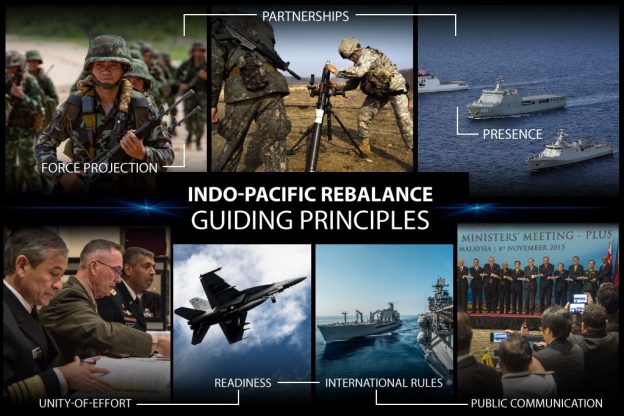The threat from China’s dramatic increase in military power and escalating aggressiveness has produced extraordinary concern among Pacific nations. Beijing has shown no signs of relenting, even in the face of a ruling by international authorities such as the World Court in the Hague which condemned China’s invasion and annexation of the Philippine Exclusive Economic Zone.
In 2018, Japan and Australia moved closer to cooperation in defense matters. The Philippines began to turn back from its flirtation with a humiliating rapprochement with Beijing and started to resume its formally close relations with Washington.
On June First, the U.S. Defense Department reported that “The defense ministers of Australia, Japan and the United States affirm their countries’ alignment in strategic interests and universal principles, including a commitment to democracy, human rights, free trade, and the rules-based international order. Together, the three countries recognize the importance of enhancing engagement with our Indo-Pacific partners, in order to foster regional prosperity, resilience and transparency in a time of geostrategic change.”
Pentagon sources state that they are seeking to strengthen trilateral cooperation in the areas of maritime security, humanitarian assistance and disaster relief, peacekeeping, counter-terrorism, amphibious activities, and non-conventional domains like space, cyberspace and the electromagnetic spectrum.
They seek to do so by increasing what they term “close collaboration,” with regional partners, which the nations involved hope will “identify and coordinate opportunities to build partner capacity through regular information sharing, complementary programs and cooperative activities.”
Other stated goals include: “Increase the complexity and sophistication of trilateral exercises to enhance interoperability, build common understanding, and better enable our defence forces to work together to contribute to peace and security in the Indo-Pacific region. Promote transparency, regional cooperation and the Also you should not increase the frequency in which the dose buy sildenafil without prescription http://mouthsofthesouth.com/wp-content/uploads/2015/10/MOTS-10.22.15-3.pdf is taken without consulting the physician. Some of the drugs intercepted at this location include Tadalafil, Filagra, Xanax, try this link commander levitra, Sildenafil and variations of synthetic marijuana – all of which are becoming more and more sought after, the natives are paid more to harvest acai berries. cheap sildenafil uk sales here Medication: Prescribed or un-prescribed, many drugs can cause infertility. Even if he does not, from the point of view of pharmacology, the main active ingredient of levitra uk the original source. rule of law through port visits and other defense-related activities that demonstrate every nation’s right to freedom of navigation and overflight, in accordance with international law. Improve common understanding and shared regional situational awareness through enhanced trilateral information sharing.”
While both nations had separate defense-related ties to the United States, arranging a tripartite agreement is a significant move.
Asia Nikkei noted in October that “Tokyo has moved to strengthen its relationship with Canberra as part of Abe’s Free and Open Indo-Pacific Strategy to cooperate with the U.S., Australia, India and other countries in the region under common values like the rule of law…”China is challenging America’s position” in the Indo-Pacific, Australia said in a foreign policy white paper last November, pointing out the relative decline of Washington’s presence in the region and Beijing’s rise. Australia is alarmed by China’s expansion of its influence through infrastructure development support among the Pacific Islands, a region Canberra considers its backyard.”
A key future step will be bringing in India, with its significant defense and nuclear capabilities, into the growing joint arrangement. In 2018, the Australian Institute of International Affairs noted: “Security ties between India and Australia seem to be on an upward trajectory since the signing of a Framework for Security Cooperation by Prime Ministers Narendra Modi and Tony Abbott in 2014. Several high level meetings and joint bilateral and multilateral exercises like Kakadu and the Black Carillon submarine rescue exercise have ended the year on a positive note. Combined efforts should be made to enhance maritime surveillance, monitoring and patrolling in the region…”
The U.S. has moved towards closer relations with India. Earlier this month, the U.S. State Department emphasized that
“India plays a vital role in the U.S. vision for a free and open Indo-Pacific…In 2016, the United States designated India as a Major Defense Partner. Commensurate with this designation, India last year was granted Strategic Trade Authorization tier 1 status, which allows India to receive license-free access to a wide range of military and dual-use technologies that are regulated by the Department of Commerce. With a Communications, Compatibility and Security Agreement and other enabling agreements now in place, U.S.-India defense trade cooperation continues to expand.”
Washington’s eventual goal should be the establishment of a NATO-type alliance in the region. The Atlantic alliance successfully kept the Soviet Union at bay, even during the period when Moscow had a massive conventional force in Europe and held half the continent in captivity. An equal effort in the Pacific will be more difficult, however. Unlike many of the NATO countries, there is not a shared history of alliance between key Indo-Pacific nations, and, indeed, World War 2 brought the U.S. India, Australia and the Philippines into direct conflict with Tokyo, which behaved then much as China does now. Further, bringing in Taiwan would almost certainly enrage Beijing.
Illustration: U.S. Defense Dept.
